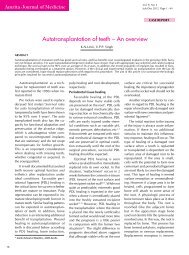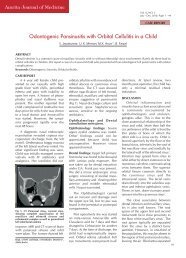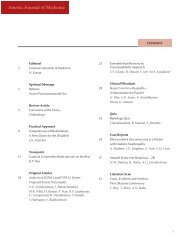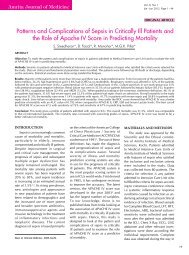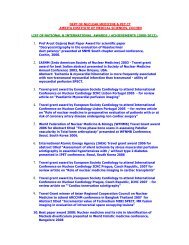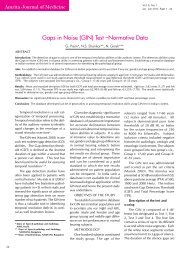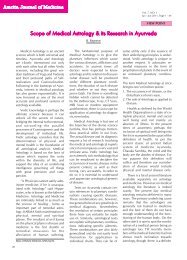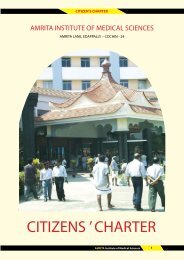Journal of Medicine Vol 2 - Amrita Institute of Medical Sciences and ...
Journal of Medicine Vol 2 - Amrita Institute of Medical Sciences and ...
Journal of Medicine Vol 2 - Amrita Institute of Medical Sciences and ...
Create successful ePaper yourself
Turn your PDF publications into a flip-book with our unique Google optimized e-Paper software.
<strong>Amrita</strong> <strong>Journal</strong> <strong>of</strong> <strong>Medicine</strong><br />
ORIGINAL ARTICLE<br />
Control Strategies for Rheumatic Fever <strong>and</strong><br />
Rheumatic Heart Disease in Wayanad, Kerala<br />
L. Krishnan, S. Vasudevan, S. Ajitha, R.K. Kumar*<br />
ABSTRACT<br />
Rheumatic Fever (RF) <strong>and</strong> Rheumatic Heart Disease (RHD) are still an important public health problem in the developing world. The disease<br />
burden appears to be closely linked to human development. A recent survey in the Ernakulam District demonstrated that the estimated disease<br />
burden <strong>of</strong> RF <strong>and</strong> RHD in this region was among the lowest in the developing world. There are parts <strong>of</strong> Kerala where access to health care <strong>and</strong><br />
human development indices are much lower than the state average. For this reason the Indian Council <strong>of</strong> <strong>Medical</strong> Research (ICMR has chosen<br />
the district <strong>of</strong> Wayanad for determination <strong>of</strong> the magnitude <strong>of</strong> RF <strong>and</strong> RHD. The services <strong>of</strong> the entire health care infrastructure <strong>of</strong> the district<br />
(both government <strong>and</strong> private) including many community volunteers are being used to identify patients with RF <strong>and</strong> RHD. The results <strong>of</strong> this<br />
study will provide interesting epidemiological insights <strong>and</strong> help plan specific control strategies.<br />
24<br />
INTRODUCTION<br />
The incidence <strong>of</strong> Rheumatic fever<br />
<strong>and</strong> prevalence <strong>of</strong> Rheumatic heart<br />
diseases have declined in the developed<br />
countries around the world,<br />
although it still remains a major public<br />
health problem in developing<br />
countries. 1 In India, a study by<br />
Padmavati 2 revealed that the estimated<br />
average prevalence <strong>of</strong><br />
rheumatic heart disease in school surveys<br />
during 1984-1995 was 0.18-3.0<br />
per 1000. Another study by<br />
Lach<strong>and</strong>ani et al 3 revealed the prevalence<br />
<strong>of</strong> RHD to be 4.54 per 1000 in<br />
the year 2000. The RF/RHD registry<br />
project <strong>of</strong> <strong>Amrita</strong> <strong>Institute</strong> <strong>of</strong> <strong>Medical</strong><br />
<strong>Sciences</strong> <strong>and</strong> Research Centre<br />
(AIMS) at Kochi, Kerala during 2003<br />
– 2004 showed the prevalence <strong>of</strong> RHD<br />
to be 0.12 per 1000, which was the<br />
lowest ever reported in India.<br />
The control <strong>of</strong> Rheumatic fever /<br />
Rheumatic Heart disease (RF/RHD)<br />
includes a broad spectrum <strong>of</strong> activities<br />
aimed at primary prevention,<br />
secondary prevention, health education<br />
activities, epidemiological<br />
surveillance <strong>and</strong> creating registry.<br />
<strong>Amrita</strong> Kripa Charitable Hospital & AIMS, Kochi.<br />
* Dept. <strong>of</strong> Pediatric Cardiology, AIMS, Kochi.<br />
The Indian Council <strong>of</strong> <strong>Medical</strong><br />
Research (ICMR), New Delhi, under<br />
the government <strong>of</strong> India, which is the<br />
apex body for the planning, formulation,<br />
coordination, implementation<br />
<strong>and</strong> promotion <strong>of</strong> biomedical research,<br />
initiated The Jai Vigyan Mission mode<br />
project on RF/RHD control. As part <strong>of</strong><br />
this project, the ICMR funded the department<br />
<strong>of</strong> Paediatric Cardiology at<br />
<strong>Amrita</strong> <strong>Institute</strong> <strong>of</strong> <strong>Medical</strong> <strong>Sciences</strong><br />
<strong>and</strong> Research Centre, Kochi to implement<br />
the RF/RHD control programme<br />
in the district <strong>of</strong> Wayanad in Kerala.<br />
Its main objectives are to establish a<br />
RF/RHD registry, sensitize the community<br />
regarding the disease <strong>and</strong> its<br />
prevention <strong>and</strong> to estimate the prevalence<br />
<strong>of</strong> RHD among school children<br />
aged 5-15 years in the district. This<br />
paper gives an overview <strong>of</strong> the ongoing<br />
activities <strong>of</strong> the project being<br />
implemented by the <strong>Amrita</strong> Kripa<br />
Charitable Hospital (AKCH), Kalpetta<br />
at Wayanad.<br />
PROJECT AREA<br />
The State <strong>of</strong> Kerala with a population<br />
<strong>of</strong> over 31 million <strong>and</strong> density <strong>of</strong><br />
819 persons per sq.km is located in<br />
the southwest part <strong>of</strong> India. Its achievements<br />
in terms <strong>of</strong> the basic indicators<br />
<strong>of</strong> human development are in par with<br />
some <strong>of</strong> the developed countries.<br />
Kerala continues to rank at the top<br />
among Indian States with respect to<br />
the human development index, although<br />
there are few variations within<br />
districts across the state.<br />
Wayanad district, the project area<br />
is located in the northern part <strong>of</strong><br />
Kerala bordering Karnataka <strong>and</strong> Tamil<br />
Nadu <strong>and</strong> has a population size <strong>of</strong><br />
nearly 7,87,000. Some <strong>of</strong> the characteristics<br />
<strong>of</strong> Wayanad include relatively<br />
low literacy rates, relative poverty <strong>and</strong><br />
a high proportion <strong>of</strong> tribal population<br />
as compared to other districts in the<br />
State. Given these conditions, the<br />
Human Development Report <strong>of</strong><br />
Kerala 4 , recommends that special attention<br />
is needed for implementing<br />
policies <strong>and</strong> programmes to improve<br />
the basic well-being indicators such<br />
as quality <strong>of</strong> housing, access to water,<br />
good sanitation. This project being<br />
implemented at Wayanad could be a<br />
stepping-stone in that direction.<br />
CONTROL STRATEGIES<br />
The Jai Vigyan Mission mode for<br />
control <strong>of</strong> RF/RHD, adopts a time<br />
bound, goal oriented approach <strong>and</strong><br />
emphasizes on st<strong>and</strong>ardized <strong>and</strong> uniform<br />
methodologies. The metho<br />
dology adopted for this project can<br />
be summarized in two components:



